Odyssey of the Otter
Hunting down peacock bass and other exotic species on the Amazon River
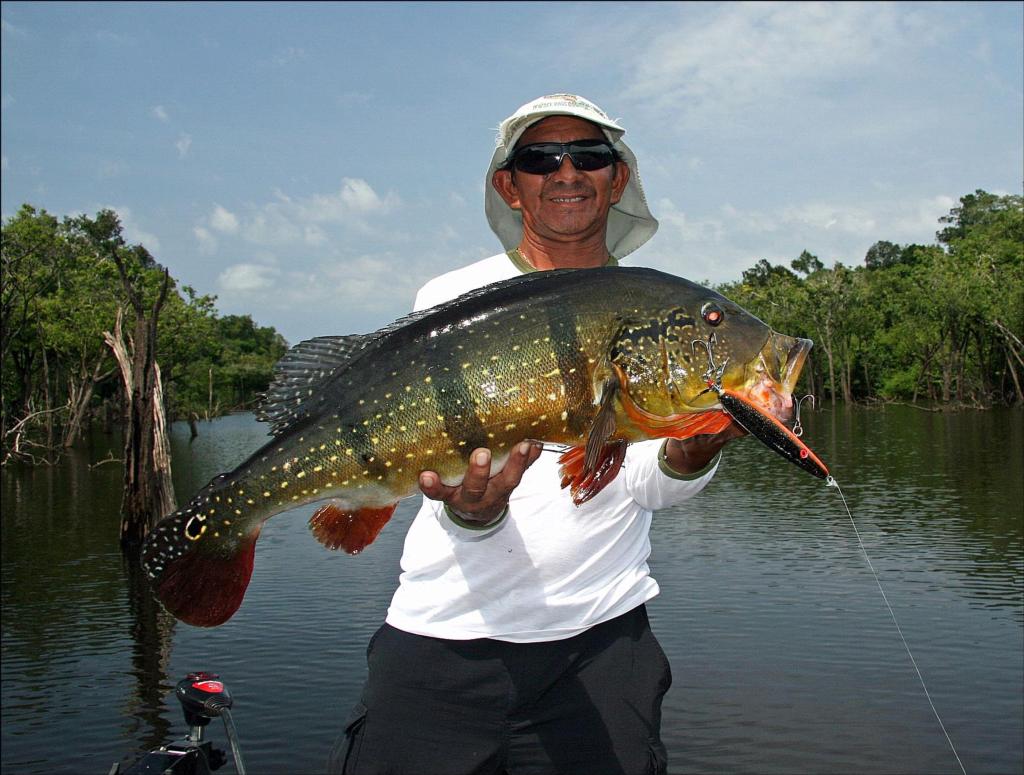
RIO JATAPU, Brazil – Maybe it was the memory of a dozen yellow-rumped caciques chattering angrily as I photographed their intricately woven basket nests. Or perhaps it was the hope of spotting more poison dart frogs like the two I had photographed an hour earlier. Could’ve been that trio of scarlet macaws that gave us a flyover, or the overwhelming magnitude of the verdant vastness surrounding one of nature’s true gems.
I don’t know what had captured my attention, but I know exactly what snatched me right back into focus – 17 pounds of Amazon fury, also known as a ticked-off speckled peacock bass.
It was around 10 a.m. when my Brazilian guide Amarol eased us into a flooded stand of marecuia trees. Brittle and brown, the dead trunks stood like stoic sentries guarding the placid backwater lagoon. We had earlier passed the remnants of a local canoe building site, but otherwise it was just us, the jungle and its residents.
The early morning had brought little action – hence, our nature watching – but when the sun pushes high in the sky, peacocks start chewing. My boat mate Sean McGuire had caught a few nice peacock bass on a red and white Bomber Long A and when I threw a heavy prop bait called a Woodchopper next to a twin stickup, it only took two good chugs to put the resident beast into kill mode.
Explosion. Blow-up. Hole-in-the-water. None of that even begins to describe the whirlwind of power and savagery that is a peacock bass strike.
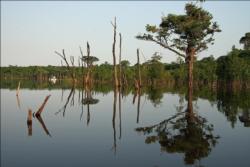 Such remote action and pristine beauty is difficult to reach. But the further you push into the Amazon interior, the better it gets. Day trips barely skim the surface – you need at least a handful of sunrises on the water to truly grasp the enormity and majesty of the world’s largest river system. Technically, the Nile is recognized as the longest continuous river on the planet, but with 20 percent of the earth’s freshwater coursing through the Amazon and its network of tributaries, there’s no debating its vastness.
Such remote action and pristine beauty is difficult to reach. But the further you push into the Amazon interior, the better it gets. Day trips barely skim the surface – you need at least a handful of sunrises on the water to truly grasp the enormity and majesty of the world’s largest river system. Technically, the Nile is recognized as the longest continuous river on the planet, but with 20 percent of the earth’s freshwater coursing through the Amazon and its network of tributaries, there’s no debating its vastness.
You would need several lifetimes to see the entire Amazon basin, as this network of secondary rivers and labyrinthine tributaries drains an area of approximately 2.7 million square miles across Peru, Ecuador, Bolivia, Venezuela and Brazil. However, commit a week to living in this matchless marvel and you’ll gain an intimate appreciation for the world’s most biodiverse region.
I recently took such a trip and experienced what felt like a lifetime of thrills and adventure in what was actually a week-long voyage in northwestern Brazil. Rich in animal life and abounding with botanical brilliance, this region defies summation – but “amazing” comes pretty close.
All aboard
No one area holds every creature, plant and fishing opportunity, so mobility increases opportunity. I experienced this truth during a recent voyage aboard one of the Amazon’s touring houseboats; this one named “Otter.” At 60 feet in length, this 4-deck, diesel-powered wooden vessel holds a dozen individually air conditioned rooms with private baths, a full kitchen, dining room, lounge, sun deck and Jacuzzi. (I once camped in the Amazon jungle, and sleeping without worry of what may join me in a tent was a welcome change).
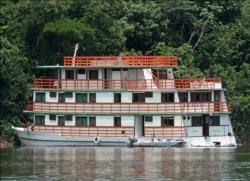 The Otter’s owner, Gilberto Castro employs aluminum bass boats from the Amazon Clipper, another river boat owned by his partner Carlos Probst. The Otter towed four bass boats off its stern, while the remaining six were strung along behind a supply boat that accompanied us on the trip. Each morning, guides picked up anglers at the Otter, fished until noonish, returned for lunch and then fished an afternoon shift.
The Otter’s owner, Gilberto Castro employs aluminum bass boats from the Amazon Clipper, another river boat owned by his partner Carlos Probst. The Otter towed four bass boats off its stern, while the remaining six were strung along behind a supply boat that accompanied us on the trip. Each morning, guides picked up anglers at the Otter, fished until noonish, returned for lunch and then fished an afternoon shift.
Our odyssey began in Manaus, the capital of Brazil’s Amazonas state and home to Eduardo Gomes International Airport where our flight from Miami, Fla., landed. The nucleus of regional travel and commerce, this port city abuts Rio Negro near The Meeting of the Waters where an aptly-named dark river converges with the lighter Amazon flow. A 30-minute commuter flight took us from Manaus to the town of Urucara on Rio Uatama (pronounced “wah-ta-mah”), a northward branching Amazon tributary. Launching around 4 p.m., we cruised all night and woke on anchor in Rio Jatapu. This smaller artery is where we spent most of our fishing time.
Because water levels vary throughout the Amazon system, the Otter varies its fishing locations for optimal peacock bass conditions. Too much water pushes fish far into shoreline cover where anglers can’t reach. Conversely, extreme low water pulls the fish away from shallow structure and into deep holes and channels where the favored topwater tactics are ineffective. Based on rain cycles and resulting river heights, the Otter fishes the Rio Negro January through March and shifts to the Uatama and its tributaries for its August-November season.
Piscatorial paradise
A poster in the Otter’s dining room showed dozens of sport fish native to the Amazon system. From the lanky aruana with its distinctly tapered tail fins to the ferocious looking pirandira sporting elongated bottom teeth, along with a multiplicity of large and small species, the Amazon River system lacks not for angling targets.
We caught a good variety with three groups dominating the action.
Peacock power play: Bold and beautiful, peacock bass are the Amazon’s top angling draw. Most common are the royals, with their olive backs, golden sides presenting dark vertical bars and reddish-orange accents on the lower fins and around the bottom jaw. Paint that fish with yellow dots and you have the speckled peacock.
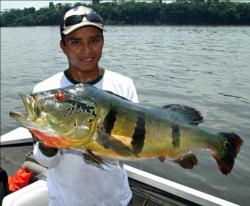 “Tucanare” in Portuguese, peacocks hit a variety of lures, but traveling fishermen come for the surface game. Jumbo Zara Spooks and giant chuggers like Creek Chub Knuckleheads will get plenty of attention, but a properly employed Woodchopper makes the kind of commotion that really ticks off the big fish. A tight cadence of reeling and violently ripping the lure across the surface produced the noisy slurps that drew those show-stopping hits.
“Tucanare” in Portuguese, peacocks hit a variety of lures, but traveling fishermen come for the surface game. Jumbo Zara Spooks and giant chuggers like Creek Chub Knuckleheads will get plenty of attention, but a properly employed Woodchopper makes the kind of commotion that really ticks off the big fish. A tight cadence of reeling and violently ripping the lure across the surface produced the noisy slurps that drew those show-stopping hits.
For me, the key was holding the rod butt against my waist, standing roughly perpendicular to my casting target and following three reel cranks with a hard sweep toward the boat. We caught peacocks in current seams off sandy points, laydowns and steep banks, but flinging those hefty baits deep into the heavy cover of flooded timber proved most productive. When a peacock boiled or missed a strike, following up with a subsurface bait often pushed the fish over the edge. In any case, you’ll appreciate stout bait-casting gear loaded with 65-pound braided line when a big peacock surges toward the wood.
Tackling toothy tyrants: When arms tired from working big lures, bottom fishing for piranhas offered a great diversion. Rio Jatapu has silver piranhas, which max out at a pound or so and the larger blacks that grow to at least three pounds. My biggest black piranha hit that mark on the hand scale and fellow angler Larry Thornhill’s best was at least a pound larger but the fish wriggled off the hook during photos.
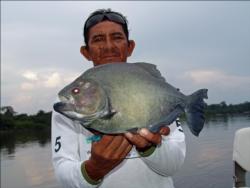 Rock piles and beach breaks were dependable for silvers, but if you want to double a rod with chunky blacks, tuck into the mouth of a backwater creek where the main river flow washes lots of chow into easy reach. When the fish are there, bites come hard and fast, but beating the surface with your rod tip simulates a struggling animal – a sound that quickly gathers a crowd of piranhas.
Rock piles and beach breaks were dependable for silvers, but if you want to double a rod with chunky blacks, tuck into the mouth of a backwater creek where the main river flow washes lots of chow into easy reach. When the fish are there, bites come hard and fast, but beating the surface with your rod tip simulates a struggling animal – a sound that quickly gathers a crowd of piranhas.
For bait, pieces of beef from the kitchen held well to hooks. We also caught piranhas on chunks of small peacock bass and various bycatch species. Because piranhas feed in packs, usually on carcasses, theirs is a grip-and-shake style of feeding intended to saw bite-size chunks with their triangular teeth. I hooked more fish by steadily reeling on the strike than I did by trying to out-quick piranhas with a snappy hook set.
Wire leaders or at least long-shank hooks are a must. We also fared well with ¼-ounce jig heads, as this kept the bait and weight in-line for a streamlined presentation. Piranhas of all sizes will take a chunk out of anything they can reach, so handle with care. Needle nose pliers or hook pluckers will keep fingers safe.
The Otter’s cooks used several of our catches for a mild and tasty piranha soup. They cut the heads off our biggest fish, boiled off the meat and sent a few of us home with authentic Amazon souvenirs that had us beaming with pride – especially when we saw what gift shops in Manaus charged for mounted piranhas that were probably scooped in nets.
Whiskered and willing: Now, the good thing about piranha fishing is that the fun didn’t end after the action subsided. Several of our toothy catches contributed to one of the Amazon’s most underrated angling activities – catfishing. Silver piranhas were cut in half with head or tail pieces equally effective as bait. The larger blacks were cut into strips. Amazon bottom dwellers liked both flavors.
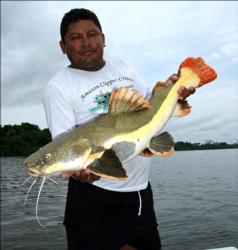 Traditional fish finder rigs comprising 2- to 4-ounce egg sinkers and 7/0 circle hooks work best for catfish, but with sinkers in short supply, guides often used heavy nuts and bolts, or even rocks, to weight their lines. Steep, rocky shorelines with good current wash and lots of jammed-up timber were the popular spots for soaking baits. Guides beached the bows of their aluminum boats on the shorelines or tethered them to overhanging branches to hold their position. When the river rolled a rig into a snag, easing upcurrent and then idling in a corkscrew pattern usually freed the captive bait.
Traditional fish finder rigs comprising 2- to 4-ounce egg sinkers and 7/0 circle hooks work best for catfish, but with sinkers in short supply, guides often used heavy nuts and bolts, or even rocks, to weight their lines. Steep, rocky shorelines with good current wash and lots of jammed-up timber were the popular spots for soaking baits. Guides beached the bows of their aluminum boats on the shorelines or tethered them to overhanging branches to hold their position. When the river rolled a rig into a snag, easing upcurrent and then idling in a corkscrew pattern usually freed the captive bait.
Amazon catfish vary greatly in size and body design – from the diminutive jurupoca, to the hulking jau and a handful of downright artistic cats like the caparari (striped catfish). Anglers rarely describe catfish as “beautiful” or “photogenic,” but the Amazon redtail catfish – locally called “pirarara” – justifies such flattery. A thick bodied fish with a yellow underside, olive tone above the lateral line, dark green freckles on its head and brilliant red tips on its tail, pectoral and dorsal fins, this stubborn fighter was our most common catch and dinnertime bespoke the redtail’s fine table fare.
Travel details
To enter Brazil, foreigners need a passport, tourist visa (complete service available at www.traveldocument.com) and proof of current yellow fever shot. Large levels of tannin from local trees wash into the Amazon system, thereby preventing mosquito production. However, if you spend much time in Brazil’s cities and towns, the Malaria risk increases. Medications vary in price and side effects.
Portuguese is the national language, but you’ll find English speaking nationals at hotels, banks and larger stores in major cities like Manaus. Brazilian currency is the real (pronounced “hey-al”) but U.S. dollars work at most establishments except small roadside vendors. Just watch the exchange rate posted daily in banks and hotels.
Ron Speed’s Adventures advises daily per person tips of $20 for fishing guides and $15 for the Otter staff. Laundry service was also available for a $20 daily fee. For information on the Otter or the Amazon Clipper, contact Ron Speed’s Adventures at www.ronspeedadventures.com.